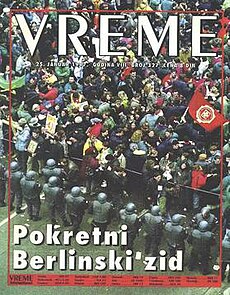Vreme
 Vreme cover, 25 January 1997 | |
| Editor-in-chief | Filip Švarm |
|---|---|
| Categories | News magazine |
| First issue | October 29, 1990 |
| Country | Serbia |
| Based in | Belgrade |
| Language | Serbian |
| Website | http://www.vreme.com |
| ISSN | 0353-8028 |
Vreme (Serbian for 'Time') is a weekly news magazine based in Belgrade, Serbia.
History
In 1990, dissatisfied with the media climate in SR Serbia, SFR Yugoslavia's largest constituent unit, a group of liberal Serbian intellectuals, including prominent lawyer Srđa Popović, decided to start a weekly news magazine. Following a seven-month preparation throughout the year, Vreme was launched with its first issue coming out on 29 October 1990,[1] a little over a month before the 1990 general election in SR Serbia as the entire country of SFR Yugoslavia was transforming its governance from a one-party system under the Yugoslav Communist League (SKJ) to a multi-party one.
Most of Vreme's original staff were journalists from Politika and NIN. It characterizes itself as "a magazine without lies, hatred, or prejudice" and opposed nationalistic mobilization for the Yugoslav wars.[2][3] During Slobodan Milošević's reign, Vreme was one of a handful of independent Serbian media outlets which resisted his influence and control and tried to counterbalance nationalist rhetoric.[4] In May 1992, it published articles on the destruction of cities in Bosnia and Croatia, and in November 1992 described attacks on cultural heritage sites (by both Serb and non-Serb forces).[5] Its design is modeled after its U.S. counterparts Time and Newsweek.[6]
In 1993, 30,000 copies were produced weekly with a quarter of its sales abroad. Vreme has established a reputation as one of the most reliable media sources of the former Yugoslavia and its writers have been largely cited by international media.[2][7]
Vreme has started a number of supplements such as Vreme novca (Time of Money), Vreme zabave (Time for Fun), and has become a publishing house.
See also
References
- ^ Robert Thomas (January 1999). Serbia Under Milošević: Politics in the 1990s. C. Hurst & Co. Publishers. p. 15. ISBN 978-1-85065-367-7. Retrieved 2 August 2015.
- ^ a b Gordy, Eric D. (1999). The Culture of Power in Serbia: Nationalism and the Destruction of Alternatives. p. 69. Penn State Press. ISBN 0-271-01958-1.
- ^ Kurspahić, Kemal (2003). Prime Time Crime: Balkan Media in War and Peace. US Institute of Peace Press. pp. 54–55. ISBN 978-1-929-22338-1.
- ^ Cull, Nicholas John; Holbrook Culbert, David; Welch, David (2003). Propaganda and Mass Persuasion: A Historical Encyclopedia, 1500 to the Present. ABC-CLIO. pp. 36–37. ISBN 978-1-576-07820-4.
- ^ Walasek, Helen (2016). Bosnia and the Destruction of Cultural Heritage. Routledge. p. 91. ISBN 978-1-317-17299-4.
- ^ Udovicki, Jasminka (2000). Burn This House: The Making and Unmaking of Yugoslavia. Duke University Press. p. 252. ISBN 978-0-822-38091-7.
- ^ Williams, Carol J. (23 March 1993). "Media : Magazine Makes Assault on Serbian Nationalism : Scrappy Vreme has emerged as Yugoslavia's most trusted chronicle of war. But it may be just as well that few read it". Los Angeles Times.
External links
- "Vreme Homepage (Archives 1998-Present)". Vreme. 17 February 2011. Archived from the original on 17 February 2011.
- "Vreme Archives (1991-1997)". Rutgers University Libraries. Archived from the original on 1 October 2007.
- "Novinari kupili nedeljnik "Vreme"". Blic Online. 23 April 2008. Archived from the original on 13 January 2013.